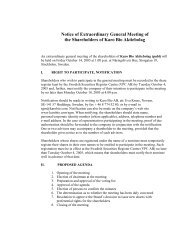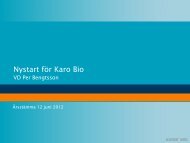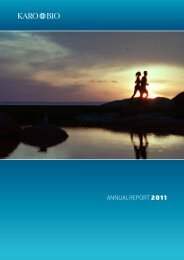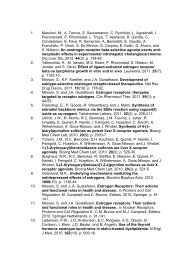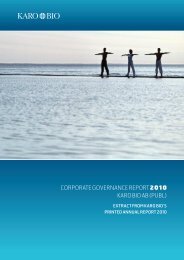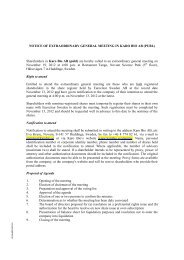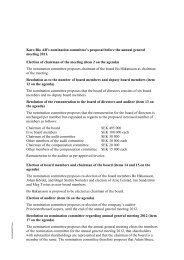Annual Report 2012.pdf - Karo Bio
Annual Report 2012.pdf - Karo Bio
Annual Report 2012.pdf - Karo Bio
You also want an ePaper? Increase the reach of your titles
YUMPU automatically turns print PDFs into web optimized ePapers that Google loves.
Accounting and valuation principles<br />
Accounting and valuation principles<br />
THE GROUP<br />
Statement of compliance<br />
The consolidated financial statements have been prepared in<br />
accordance with the Swedish <strong>Annual</strong> Accounts Act, RFR 1 Supplementary<br />
Accounting Regulations for Groups, International<br />
Financial <strong>Report</strong>ing Standards (IFRS) and statements concerning<br />
interpretation published by IFRIC as adopted by the European<br />
Union. The statements have been prepared on a historical cost<br />
basis, except for financial assets available for sale and financial<br />
assets at fair value through profit and loss.<br />
CHANGES IN ACCOUNTING PRINCIPLES AND INFORMATION<br />
New accounting standards applied by the group<br />
None of the IFRS or IFRIC interpretations, mandatory for the<br />
first time in the financial year beginning January 1, 2012 have had<br />
a significant impact on the Group.<br />
New standards, amendments and interpretations to existing<br />
standards that have not been adopted proactively by the group<br />
A number of new standards, interpretations and amendments<br />
to existing standards will be effective for fiscal years beginning<br />
after January 1, 2013 and have not been applied in preparing<br />
the consolidated financial statements. Included amongst are the<br />
standards below which are not expected to have any significant<br />
impact on the Group’s financial statements.<br />
IAS 1 ”Presentation of Financial Statements” has introduced<br />
changes to other comprehensive income. The most significant<br />
change in the revised IAS 1 is the requirement that the items<br />
recognized in ”other comprehensive income” be presented in two<br />
groups.<br />
The distribution is based on if the entries may be reclassified<br />
to the income statement (reclassification adjustments) or not.<br />
The amendment does not address the question of which records<br />
should be included in ”other comprehensive income”.<br />
IFRS 9 ”Financial instruments” deals with the classification,<br />
valuation and reporting of financial liabilities and assets. IFRS<br />
9 replaces those parts of IAS 39, which are related to the classification<br />
and valuation of financial instruments. IFRS 9 requires<br />
that financial assets are classified into two different categories:<br />
valuation at fair value or valuation at amortized cost.<br />
Classification is determined at initial reporting based on the<br />
company’s business model and characteristics of the contractual<br />
cash flows. For financial liabilities there are no large changes<br />
compared with IAS 39. The biggest change relates to liabilities<br />
that are designated at fair value. For these, a portion of fair value<br />
changes that is attributable to their own credit risk is recognized<br />
in other comprehensive income instead of the result as long as<br />
it does not causes inconsistency in the accounting. The Group<br />
intends to apply the new standard by the financial year beginning<br />
January 1, 2015 and has not yet evaluated the effects. The standard<br />
has yet not been adopted by the EU at the time of this report.<br />
IFRS 10 ”Consolidated Financial Statements” is based on existing<br />
principles as it identifies control as the decisive factor for determining<br />
whether a company is fully consolidated. This standard<br />
provides additional guidance to assist in the determination of<br />
control when this is difficult to assess. The Group will apply IFRS<br />
10 for the financial year beginning January 1, 2014 and has not yet<br />
evaluated the full impact on the financial statements.<br />
IFRS 12 ”Disclosures of interests in other entities” includes<br />
disclosure requirements of subsidiaries, joint arrangements, associates<br />
and non-consolidated ”structured entities”. The Group<br />
will apply IFRS 12 for the financial year beginning January 1,<br />
2014 and has yet not evaluated the full impact on the financial<br />
statements.<br />
The aim of IFRS 13 ”Fair value measurement” is that valuation<br />
at fair value should be more consistent and less complex<br />
by providing a standard that gives a precise definition and a<br />
common source of IFRS at fair value valuations and associated<br />
information. The requirements do not increase the application<br />
scope of when fair value should be applied but provides guidance<br />
on how it should be applied where other IFRSs already require<br />
or permit valuation at fair value.<br />
Basis of preparation<br />
The consolidated financial statements have been prepared on<br />
a historical cost basis, except for certain financial instruments<br />
that are measured at fair value. Amounts are expressed in KSEK<br />
(thousands of Swedish kronor) unless otherwise indicated. MSEK<br />
is an abbreviation for millions of Swedish kronor. Amounts or<br />
figures in parentheses indicate comparative figures for 2011 and<br />
2010, respectively.<br />
Critical accounting estimates and judgments<br />
The preparation of financial statements requires the use of certain<br />
critical accounting estimates. It also requires management to<br />
exercise its judgment in the process of applying the company’s<br />
accounting principles. Estimates and judgments are continually<br />
evaluated and are based on historical experience and other factors,<br />
including expectations of future events that are believed to be<br />
reasonable under the circumstances.<br />
The areas involving a higher degree of judgment or complexity,<br />
or areas where assumptions and estimates are significant to the<br />
financial statements, relate to the valuation of tax losses carried<br />
forward, the valuation of stock options issued to employees and<br />
the decision regarding expensing or capitalizing development<br />
costs. For further information, see accounting and valuation<br />
principles below and notes 9 and 27.<br />
KARO BIO <strong>Annual</strong> <strong>Report</strong> 2012 23



